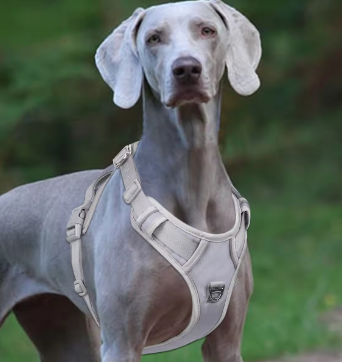If your dog runs away from his harness, you’re not alone. Many dog owners face this challenge, and it can be frustrating when something as simple as getting ready for a walk turns into a chaotic ordeal. Understanding the reasons behind your dog's behavior and learning how to address it can make harness time much smoother. Here’s a comprehensive guide to help you and your dog overcome harness aversion.
Understanding the Aversion
Dogs may dislike their harness for various reasons:
- Discomfort: The harness might be uncomfortable or painful. Check for proper fit and any areas that may rub or pinch.
- Fear of Restraint: Some dogs don't like being restrained or having things put over their heads.
- Association with Stress: If harness time has been chaotic or stressful, your dog might associate the harness with those negative experiences.
- Past Negative Experiences: If your dog has had a bad experience with a harness in the past, it can lead to a lasting aversion.
Training Steps to Overcome Harness Aversion
-
Positive Association
- Step 1: Start by showing your dog the harness and giving them a treat immediately. Repeat this several times a day until your dog is excited to see the harness.
- Step 2: Hold the harness open and let your dog sniff it. Reward them for any positive interaction, such as sniffing or touching it with their nose.
-
Desensitization and Counter-Conditioning
- Step 3: Hold a treat in front of the harness's head loop. Let your dog reach through the loop to get the treat. This encourages them to voluntarily put their head through the harness.
- Step 4: Gradually increase the duration before giving the treat. Start with just the nose, then part of the face, and eventually the entire head. Reward every successful attempt.
- Step 5: If your harness has a clasp, desensitize your dog to the sound. Say “clip,” clip it, and immediately give a treat. Do this several times until the sound doesn't bother your dog.
-
Gradual Introduction to Wearing the Harness
- Step 6: Once your dog is comfortable with putting their head through the harness, start fastening it. You might need a lick mat or treats scattered on the ground to keep them distracted.
- Step 7: If your dog shows signs of discomfort (e.g., lip licking, ears back, tail tucked), take a step back and go through the previous steps again. Patience is key.
-
Practice Makes Perfect
- Step 8: Leave the harness on your dog for short periods, gradually increasing the duration. This helps your dog get used to the feeling of wearing it.
- Step 9: Incorporate the harness into playtime or other enjoyable activities to build a positive association.
Tips for Success
- Stay Calm: Your dog can sense your emotions. Remain calm and use a soothing voice during the entire process.
- Use High-Value Treats: Find out what your dog loves the most—whether it’s cheese, hot dogs, or boiled chicken—and use that for training.
- Be Consistent: Consistency is crucial. Practice these steps daily until your dog is comfortable.
- Avoid Overfeeding: Ensure you’re not overfeeding your dog during training sessions. Adjust their meal portions if necessary.
Troubleshooting Common Issues
-
Dog Runs Away at the Sight of the Harness
- Go back to the basics of positive association. Show the harness and reward your dog without trying to put it on them.
-
Dog Resists Once the Harness is On
- Use distractions like treats or a favorite toy. Allow your dog to wear the harness during positive activities, like playtime.
-
Dog Hates the Clasp Sound
- Desensitize your dog to the sound by practicing the “clip” and treat method away from their body before trying it on the harness.
Real-Life Experiences
Here’s what worked for other dog owners:
- Treat Through the Loop: One dog owner used treats to lure their dog’s head through the harness loop, rewarding them every time. Gradually, the dog associated the harness with treats and became more cooperative.
- Kibble Distraction: Another owner scattered kibble on the floor, allowing their dog to focus on picking it up while they clipped the harness on. This distraction technique proved effective.
- Standing Command: Teaching a dog to stand on command can make harnessing easier. Holding a treat higher than the dog’s nose encourages them to stand, allowing the owner to slip the harness on without resistance.
Conclusion
Harness aversion can be challenging, but with patience, positive reinforcement, and consistent training, you can help your dog overcome their fear. Remember, every dog is different, and it may take time for your dog to feel comfortable with the harness. By making the harness a positive and stress-free part of your dog’s routine, you can look forward to enjoyable walks together.

